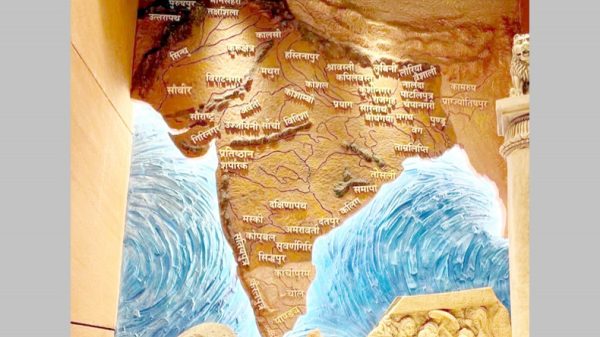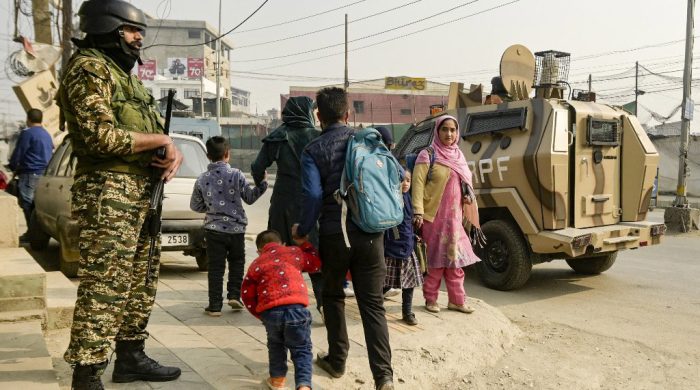India’s ‘Akahnd Bharat’ map and the rest of us

- Update Time : Thursday, June 8, 2023
- 78 Time View

WHY a state which is run by practical-minded adults, perfectly aware of regional and global sensibilities, would want to do something as painting a mythological map covering much of the region on its hallowed official building beats most people outside Hindutva supporters.
It is worse than the Islamic ummah- and Khilafat-type imageries as they have no material base any more to begin with to even cause any sense of threat. But this Vedic map is not scary but more of the naive variety. It is potentially damning for India because the last thing one needs in today’s world is to have less friends close by. Nobody can match India’s size and clout, but it has acted as if it needs others to recognise its supremacy rather visually and loudly rather than the obvious reality that does not need such overt statements. It will soon also make Chinese maps look more intrusive than India would like them to be.
Frankly, China is psychologically distant, but India is next-door in every sense. Nobody travels to India to see doctors and buy saris and even books but with one map that has no concrete historical need, it has collected more enemies than friends. If India wants to pretend, it does not care if it loses well-wishers and friends, one would be seriously worried.
Mythological maps and current India
THERE are many such imaginations in the ancient world and all are about a world that was largely imagined. It does not make any difference if they existed in reality or not because they were all products of fantasy and wish fulfilment of a world now gone. Sure, it is part of the legacy but nobody takes it seriously when dealing with today’s contemporary world and its issues.
India is, however, unwilling to let go of its past as part of its contemporary reality. The basic idea is that today’s India is larger, bigger, wiser and master of the world that was imagined by some people in a part of North India centuries ago. In many ways, this is not a reflection of South India even, which resisted the Aryan expansion as described in the sacred mythologies of the Ramayana and the Mahabharat but a part of North India.
It is an issue largely circulating and kept alive in the North Indian heartland of Bihar, Uttar Pradesh, Maharashtra and a few other areas. Sadly, these areas also happen to be the poorer part of India, unable to match the rising prosperity of the south. In more than one ways, it is a reflection of the conflict within India of what it should look like to its own citizens and what it is in large pockets. While the south focuses on education, technology, etc, the north seems to find greater satisfaction in harkening path to a myth it believes in while waiting for a massive economic growth.
And erased states all around?
TO THE Indians who support the map variety, it is a declaration of India’s greatness and size and growth and, maybe, ambition. It wants to be respected and feared and hopes to be treated not as equals but as higher than others. This is fine as most Indians want that, but such themes recur in songs, musicals and folk literature and not in official discourses.
In religious evangelicalism where trumpeting the ‘glory of Islam including expanding the borders beyond and ‘getting rid of the infidels type’ talk is common, this may work. But this is not mainstream. To the naïve listeners at these waz mehfils, they are often entertainment and no more.
The increasingly hard-nosed Bangladeshis have altered their pious coats to have larger pockets no matter from where and how the coins drop. People are obsessed with becoming better off by fair means or foul and go full steam ahead to money-making. The past exists if it can be made into shoddy goods and sold. Its break with not just its imaginary past but its real history of sorts is very unusual but real. Meanwhile, India wants its past back.
Does India look bigger now?
TO BE frank, most are not that much bothered about what the map means. A few of the cognoscenti have made their rue known on Facebook and maybe a few snap op-eds, but no more than that. It has more to do with the present ruling party’s proximity with India rather than really taking India’s map spectacle seriously that sparked such comments. And that means India’s national branding is being ignored and not being taken seriously.
Pakistan and Nepal have officially let their ire be known and Bangladesh has stated that it will ask for an explanation, too, but that has not exactly meant boats are being rocked. The electricity, heat wave and coal-buying dollar crisis take front stage and nobody has spare time to dwell on India’s supposed past obsession.
And that may well be the point that India keeps missing. Nobody really cares about what one imagined in the past. It is what one does in the present that matters and this map reflecting the ambitions of the once militarily powerful ruling zone is simply out of date. India needs to identify its present better.
Afsan Chowdhury is a researcher and journalist.

























